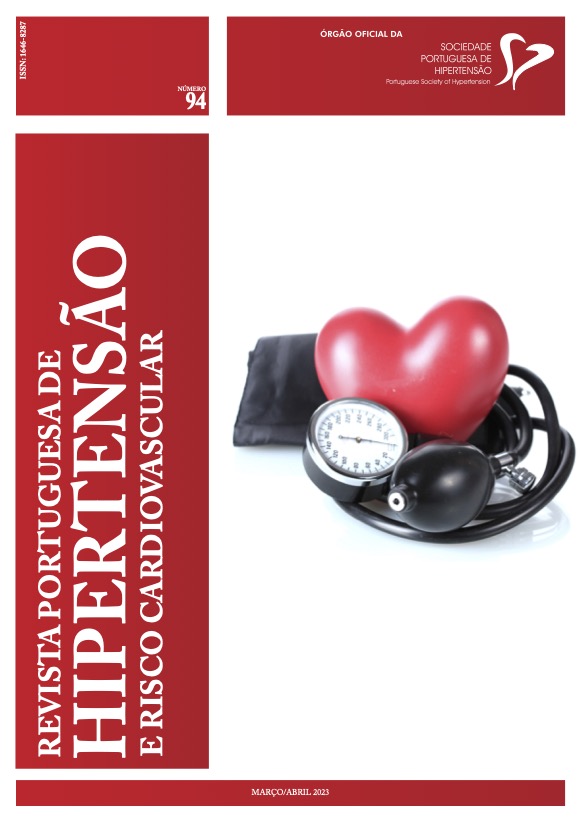SARS-COV-2: An Intruder In The Renin-Angiotensin-Aldosterone System
DOI:
https://doi.org/10.58043/rphrc.76Keywords:
Arterial hypertension, Angiotensin Converting Enzyme Inhibitors, Angiotensin II Receptor Blockers, COVID-19, SARS-CoV-2, PneumoniaAbstract
Introduction: The new severe acute respiratory syndrome coronavirus 2 (SARS-CoV-2) uses angiotensin-2 converting enzyme (ACE 2) to enter cells. It is theorized that the use of angiotensin converting enzyme inhibitors (ACEIs) and angiotensin II receptor blockers (ARBs) would increase this enzyme expression, raising the hypothesis that these drugs increase the susceptibility to coronavirus disease 2019 (COVID-19) and could be associated with a worse prognosis. However, subsequent studies show neutral effects and others even beneficial of these drugs, making further investigation essential to ascertain the real impact of these drug classes on the presentation, clinical course and prognosis of COVID-19.
Objective: Analyze in patients hospitalized due COVID-19 the differences between the group of patients taking ACEIs or ARB (gACEI/ ARB) and the group not taking these drugs (gNoACEI/ARB), regarding demographic characteristics, prevalence of comorbidities, common symptoms of COVID-19, blood test, arterial blood gas and radiological alterations, bacterial superinfection, admission to intensive care unit, length of stay and mortality.
Material and Methods: Retrospective study of patients hospitalized by COVID-19, at Centro Hospitalar Tondela-Viseu, from March 15 to May 18, 2020, using data from the clinical files of Sclinico and ALERT® and statistics analysis through SPSS®.
Results: Of the 89 patients included in the study, 38.20% were women. The mean age in the sample was 73.26 ± 16.26 years. 55.06% had arterial hypertension, 33.71% of patients in the sample were on ACEIs or ARBs. The mean age was identical in both groups (77.93 ± 10.40 in the gACEI/ARB vs 70.88 ± 18.17 years in the gNoACEI/ARB, p=0.264). 46.67% were women in the gACEI/ARB and 33.90% in the gNoACEI/ARB (p=0.241). The prevalence of diabetes mellitus (DM) was higher in the gACEI/ARB (43.33 vs 22.03%, p=0.037), as well as heart failure (HF) (36.67% vs 27.12%, p=0.354). Dyspnea was more frequent in the gACEI/ARB (56.67 vs 54.24%, p=0.828), but not cough or fever (46.67 vs 50.85%, p=0.709 and 40.00 vs 54.24%, p=0.204). There were no significant differences in the blood test and arterial blood gas parameters, in the emergency department, between gACEI/ARB and gNoACEI/ARB, namely in the mean value of leukocytes (respectively, 11.73 vs 9.03 x 109/L, p=0.186), neutrophils (8.56 vs 6.63 x 109/L, p=0.112), lymphocytes (1.16 vs 1.21 x 109/L, p=0.714), platelets (212.59 vs 209.69 x 109/L, p=0.881), C-reactive protein (6.69 vs 8.48 mg/dL, p=0.247), procalcitonin (1.12 vs 3.73 ng/mL, p=0.472), arterial blood pH (7.44 vs 7.45, p=0.820), lactates (1.85 vs 1.43 mmol/L, p=0.172) and the PaO2/FiO2 ratio (248.02 vs 271.70, p=0.228). The percentage of patients with evidence of pneumonia on chest X-rays was identical in both groups (50.00 vs 64.41%, p=0.191) and also the percentage of patients who started antibiotic therapy for suspected bacterial superinfection (60.00 vs 67.80%, p=0.466). 13.33% of gACEI/ARB and 10.17% of gNoACEI/ARB patients required admission to intensive care unit (p=0.728). The mean length of stay was slightly longer in gACEI/ARB (20.13 vs 15.75 days, p=0.246), but mortality was lower (10.00 vs 16.95%, p=0.530).
Conclusions: There were no statistically significant differences between the two groups regarding age and gender distribution. As expected, in gACEI/ARB, comorbidities such as DM and HF were more prevalent. On the other hand, there were also no statistically significant differences between the two groups in terms of symptoms of COVID-19, blood test, arterial blood gas and radiological changes, presence of pneumonia and bacterial superinfection, need for admission to intensive care unit, length of stay and mortality. Thereby, despite the initial alarm about the possible harmful effects of ACEIs and ARBs on COVID-19, further studies did not confirm this hypothesis. The present study, by not finding significant differences between the presentation, clinical course and prognosis of the disease between patients under ACEIs or ARBs and patients who were not taking these drugs, also meets the recommendations of several societies in the arterial hypertension area, which recommend the maintenance of this therapy in patients with COVID-19.
Downloads
References
LiuY,KuoR,ShihS,COVID-19:Thefirstdocumented coronavirus pandemic in history. Biomedical Journal. 2020; 43: 328-333. doi: 10.1016/j.bj.2020.04.007
Wang D,Hu B,Hu C,Zhu F,Liu X,Zhang J,et al. Clinical. Characteristics of 138 Hospitalized Patients With 2019 Novel Coronavirus-Infected Pneumonia in Wuhan, China. Jama. 2020; ;323(11):1061–1069. doi:10.1001/jama.2020.1585
Li B,Yang J,Zhao F,Zhi L,Wang X,Liu L,et al. Prevalence and impact of cardiovascular metabolic diseases on COVID-19 in China. Clinical Research in Cardiology. 2020; 109:531–538. doi: 10.1007/s00392- 020-01626-9
Bavishi C, Maddox T, Messerli F. Coronavirus Disease 2019 (COVID-19) Infection and Renin Angiotensin System Blockers. JAMA Cardiol. 2020;5(7):745–747. doi:10.1001/jamacardio.2020.1282
Vickers C, Hales P, Kaushik V, Dick L, Gavin J, Tang J, et al. Hydrolysis of biological peptides by human angiotensin-converting enzyme-related carboxypeptidase. J Biol Chem. 2002;277(17):14838- 43. doi: 10.1074/jbc.M200581200.
Li W,Zhang C,Sui J,Kuhn J,Moore M,Luo S,et al. Receptor and viral determinants of SARS-coronavirus adaptation to human ACE2.EMBO J.2005;24(8):1634- 43. doi: 10.1038/sj.emboj.7600640.
Byrd J, Ram C, Lerma E. Pharmacologic treatment of hypertension. Nephrology Secrets. Elsevier. 2019, 477– 482. doi:10.1016/b978-0-323-47871-7.00078-2
Fang L, Karakiulakis G, Roth M. Are patients with hypertension and diabetes mellitus at increased risk for COVID-19 infection? Lancet Respir Med. 2020;8(4):e21. doi: 10.1016/S2213-2600(20)30116-8.
Kuba K,Imai Y,Rao S,Gao H,Guo F,Guan B,et al.A crucial role of angiotensin converting enzyme 2 (ACE2) in SARS coronavirus-induced lung injury. Nat Med. 2005;11:875-879. doi: 10.1038/nm1267
Zhang X,Yu J,Pan LY,Jiang HY.ACEI/ARB use and risk of infection or severity or mortality of COVID-19: A systematic review and meta-analysis. Pharmacol Res. 2020;158:104927. doi:10.1016/j.phrs.2020.104927
Rico-Mesa JS, White A, Anderson AS. Outcomes in Patients with COVID-19 Infection Taking ACEI/ ARB. Curr Cardiol Rep. 2020 Apr 14;22(5):31. doi: 10.1007/s11886-020-01291-4
Li X, Zhang J, Zhuo J. The vasoprotective axes of the renin-angiotensin system: Physiological relevance and therapeutic implications in cardiovascular, hypertensive and kidney diseases. Pharmacol Res. 2017.125(Pt A):21-38. doi: 10.1016/j.phrs.2017.06.005.
Sriram K, Insel PA. Risks of ACE Inhibitor and ARB Usage in COVID-19: Evaluating the Evidence. Clin Pharmacol Ther. 2020;108(2):236-241. doi: 10.1002/cpt.1863
Kreutz R, Algharably E, Azizi M, Dobrowolski P, Guzik T, Januszewicz A, et al. Hypertension, the renin- angiotensin system, and the risk of lower respiratory tract infections and lung injury: implications for COVID-19. Cardiovasc Res. 2020;116(10):1688-1699. doi:10.1093/ cvr/cvaa097
Downloads
Published
How to Cite
Issue
Section
License
Copyright (c) 2023 Inês Cunha, Daniel Aparício, Andreia Lopes, Inês Bagnari, Joana Cunha, Rui Marques, Vera Romão

This work is licensed under a Creative Commons Attribution 4.0 International License.




